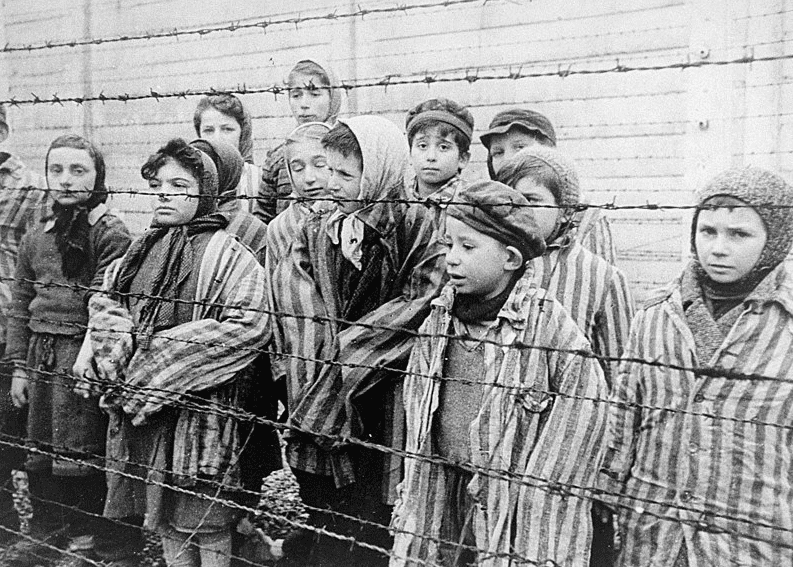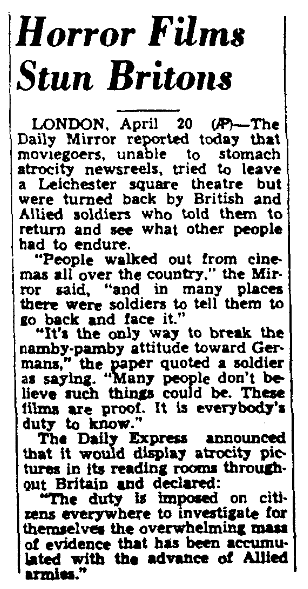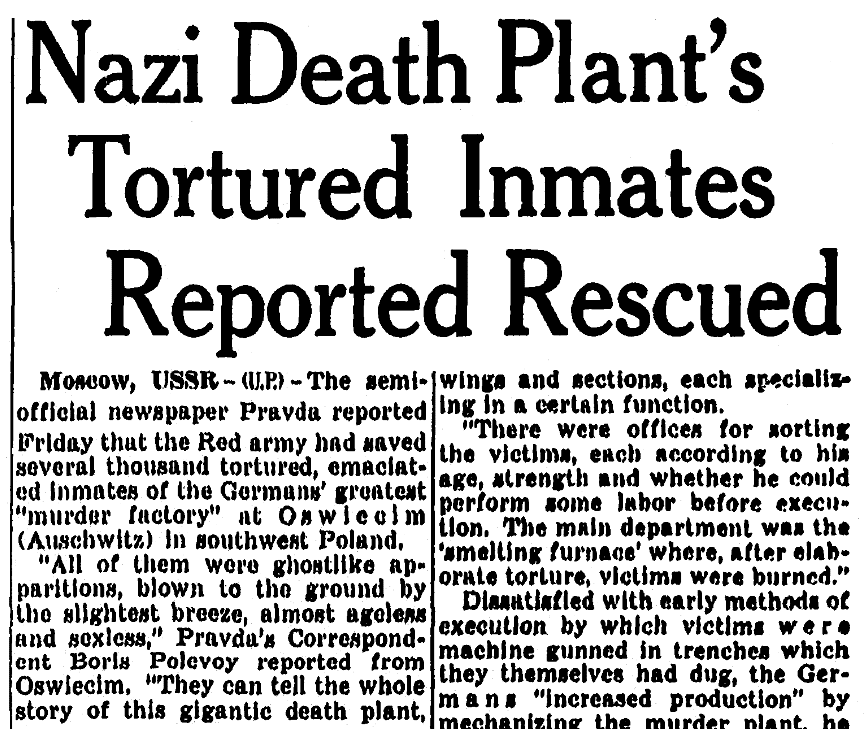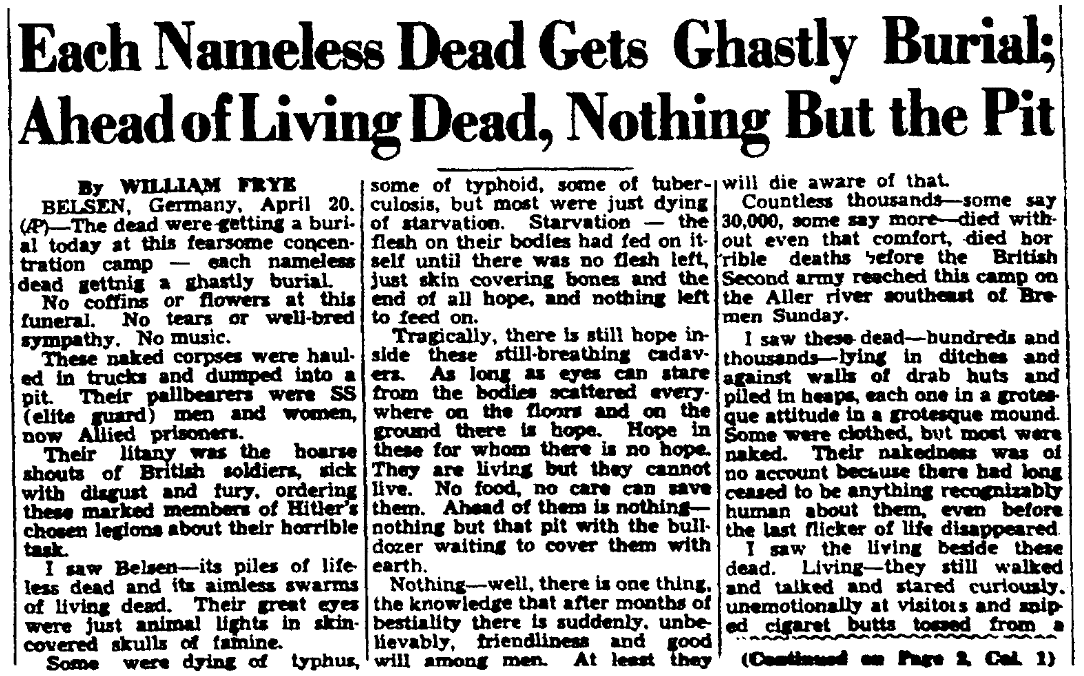Today is International Holocaust Remembrance Day, decreed by the United Nations in 2005 to commemorate the victims of the Holocaust – a horrific program in which Nazi Germany murdered between 11 and 17 million people, approximately 6 million of them Jews. The date was chosen because Soviet troops liberated Auschwitz, the largest of the concentration camps, on 27 January 1945 in German-occupied Poland.

What the liberating troops saw in the Nazi death camps horrified and sickened them; civilians had the same reaction later when the truth became public and they saw atrocity newsreels. Many moviegoers did not want to see.

Here is a transcription of this article:
Horror Films Stun Britons
LONDON, April 20 (AP) – The Daily Mirror reported today that moviegoers, unable to stomach atrocity newsreels, tried to leave a Leichester square theatre but were turned back by Britith and Allied soldiers who told them to return and see what other people had to endure.
“People walked out from cinemas all over the country,” the Mirror said, “and in many places there were soldiers to tell them to go back and face it.”
“It’s the only way to break the namby-pampy attitude toward Germans,” the paper quoted a soldier as saying. “Many people don’t believe such things could be. These films are proof. It is everybody’s duty to know.”
The Daily Express announced that it would display atrocity pictures in its reading rooms throughout Britain and declared:
“The duty is imposed on civilians everywhere to investigate for themselves the overwhelming mass of evidence that has been accumulated with the advance of Allied armies.”
The next two newspaper articles make for difficult reading, but – as the unnamed solider quoted in the article above stated – “It is everybody’s duty to know.”
This first article is based on the reporting of Boris Polevoy, a correspondent with the Soviet newspaper Pravda, from Auschwitz.

Here is a transcription of this article:
Nazi Death Plant’s Tortured Inmates Reported Rescued
Moscow, USSR – (U.P.) – The semi-official newspaper Pravda reported Friday that the Red army had saved several thousand tortured, emaciated inmates of the Germans’ greatest “murder factory” at Oswiecim (Auschwitz) in southwest Poland.
“All of them were ghostlike apparations, blown to the ground by the slightest breeze, almost ageless and sexless,” Pravda’s Correspondent Boris Polevoy reported from Oswiecim. “They can tell the whole story of this gigantic death plant, equipped with the most modern Nazi technology of torture and extermination.”
Fragmentary reports indicated that at least 1,500,000 persons were slaughtered at Oswiecim, Polevoy said. During 1941, 1942 and early 1943, he said, five trains arrived daily at Oswiecim with Russians, Poles, Jews, Czechs, French and Yugoslavs jammed in sealed cars. The trains always left empty.
Saturated with Blood
“The first shock of Oswiecim is its enormous size,” Polevoy said. “Dozens of square miles are saturated with human blood and literally blanketed with human ashes. This was a great industry with many wings and sections, each specializing in a certain function.
“There were offices for sorting the victims, each according to his age, strength and whether he could perform some labor before execution. The main department was the ‘smelting furnace’ where, after elaborate torture, victims were burned.”
Dissattisfied with early methods of execution by which victims were machine gunned in trenches which they themselves had dug, the Germans “increased production” by mechanizing the murder plant, he said.
An Elaborate Apparatus
Perhaps the most elaborate apparatus was an electric conveyor belt on which hundreds of persons could be electrocuted simultaneously, then moved on the belt directly into furnaces. “They were burned almost instantly, producing fertilizer for near-by cabbage fields,” Polevoy said.
Gas chambers also were built, he said, “But liberated prisoners say death was most merciful compared to the ordeal of hunger, cold and bodily torture to which victims were subjected prior to execution,” he added.
“I saw leather covered steel rods used for beating prisoners. I saw zinc lined benches with leather straps on which victims were beaten to a pulp. I saw heavy oak chairs on which victims were killed after their backs were broken. I saw rubber truncheons with the trademark ‘Krutz’ of Dresden for crushing heads and sexual organs.”
There were no American reporters with the Soviets when they liberated Auschwitz in January, but William Frye was brought to the Belsen concentration camp shortly after the British liberated it on 15 April 1945. Despite his disgust and grief at what he saw, he pulled himself together to write a shocking news report. While Frye gets carried away at times, imagining what the prisoners are feeling when of course only those who had truly experienced the horror could know, his graphic eyewitness account of the camp’s condition and its inmates creates a powerful, deeply painful record.

Here is a transcription of this article:
Each Nameless Dead Gets Ghastly Burial;
Ahead of Living Dead, Nothing but the Pit
By William Frye
BELSEN, Germany, April 20. (AP) – The dead were getting a burial today at this fearsome concentration camp – each nameless dead getting a ghastly burial.
No coffins or flowers at this funeral. No tears or well-bred sympathy. No music.
These naked corpses were hauled in trucks and dumped into a pit. Their pallbearers were SS (elite guard) men and women, now Allied prisoners.
Their litany was the hoarse shouts of British soldiers, sick with disgust and fury, ordering these marked members of Hitler’s chosen legions about their horrible task.
I saw Belsen – its piles of lifeless dead and its aimless swarms of living dead. Their great eyes were just animal lights in skin-covered skulls of famine.
Some were dying of typhus, some of typhoid, some of tuberculosis, but most were just dying of starvation. Starvation – the flesh on their bodies had fed on itself until there was no flesh left, just skin covering bones and the end of all hope, and nothing left to feed on.
Tragically, there is still hope inside these still-breathing cadavers. As long as eyes can stare from the bodies scattered everywhere on the floors and on the ground there is hope. Hope in these for whom there is no hope. They are living but they cannot live. No food, no care can save them. Ahead of them is nothing – nothing but that pit with the bulldozer waiting to cover them with earth.
Nothing – well, there is one thing, the knowledge that after months of bestiality there is suddenly, unbelievably, friendliness and good will among men. At least they will die aware of that.
Countless thousands – some say 30,000, some say more – died without even that comfort, died horrible deaths before the British Second army reached this camp on the Aller river southeast of Bremen Sunday.
I saw these dead – hundreds and thousands – lying in ditches and against walls of drab huts and piled in heaps, each one in a grotesque attitude in a grotesque mound. Some were clothed, but most were naked. Their nakedness was of no account because there had long ceased to be anything recognizably human about them, even before the last flicker of life disappeared.
I saw the living beside these dead. Living – they still walked and talked and stared curiously, unemotionally at visitors and snipped cigaret butts tossed from a passing army car, went to the cookhouse for food and knelt around fires. There were supposed to be 29,000 of them alive when the British arrived. Living – but hardly men and women now, their spirits so broken and degraded that the nameless horror around them was without meaning or significance.
I saw there was no sex, no shame, no modesty, no self-respect among these people – driven in a few months backward a million years towards primordial scum.
Some habits remained. Women stood naked cleaning themselves with cans of water, unconscious of their flat, empty nakedness.
Men, equally naked, also remembered the habit of bathing. Clothing to these people meant warmth, nothing else.
I saw children walking about in this hell. Children – the first I saw I’ll never rub out of my mind. A boy, perhaps seven, and his sister, maybe five. The knobs of their joints bulging through their thin clothes, faces like mummies, timorously sneaking up with small pails towards a water truck, their great fierce eyes intent on a chance to rush in and steal pails-full of water.
Obviously they were unable to comprehend something being freely given. It was agony to watch their stealthy approach, keeping always behind a British soldier who was there helping all who came.
I saw SS men and women, once the torturing, brutal guards of this purgatory beyond imagination, put to labor loading the bodies of the people they had killed into trucks. I saw them at the pits unloading these human carcasses, dragging them through the sand and dumping them into a great hole half-filled with dead. I saw these dead – dead long beyond rigor mortis – tumble limply into the vast common grave that hid their namelessness forever.
I saw the living and dead lying beside each other in filthy huts – long, barracks-like buildings – the living no more able to rise than the dead.
I saw men eating food just brought from the cookhouse, eating within a yard of corpses dead for days, unconcerned by the death beside them or by the stench from slow-burning heaps of rags impregnated with filth.
Outside one of these huts within a barbed-wire compound I saw a smouldering heap of rags, and underneath it the half-burned body of a man, dragged out with the rags and undiscovered until the gradually consumed waste disclosed this one-time human among the ashes. Not that it would have made any difference to the others if they had known.
Inside this hut I saw and heard something else. Inside this hut I choked and cried. What once were men lay on the floor clothed in rags. Already they lay in the same grotesque macabre attitudes of the corpses on the heaps a few yards away.
A major who took me there, Major J. P. Fox of Dublin, Ireland, commander of a field hygienic unit told me “nothing can help these poor wretches. We can’t even feed them. They are too far gone to retain any food. They are dying and there is nothing we can do about it.”
There they lay, already pushing through the gates of death. As we walked through the door they were cheered. We could see the light of deliverance flash into those dying eyes. One or two feeble, wasted arms came slowly up and waved a “V” sign slowly in the air. The ghosts of voices quavered something that sounded like “hurrah” at the sight of Allied uniforms.
The major, another American correspondent and I staggered out of the hut, unable to see or speak and Major Fox said, “I think I have shown you all there is to see in this place.”
But he had shown me only a little. There was more – much more.
He showed me proof that the human spirit can survive even such calculated evil as was practiced in this abominable spot. He took me to the cookhouse and introduced me to a Polish woman who for several years had been an inmate of German prisons and concentration camps.
She had been in Belsen seven months. Previously she had been confined even longer in famous Auschwitz in Poland and for 27 months in prison – in the relative comfort of prison – in Berlin.
We were received in her miserable little room in the cookhouse – hers since the liberation – as in a castle drawing room. She spoke English – brokenly, cautiously – but she spoke English, and talked. With restraint, with great care, without bitterness, she talked.
This is what I heard:
Josef Kramer, SS commander of Belsen now under close arrest, previously commanded Auschwitz, where children were taken from their mothers and burned alive, where a gas chamber killed thousands, where Kramer kept his own orchestra to entertain him with Strauss waltzes while abominations were practiced under his command outside his windows.
At Belsen, Kramer’s predecessor, also of the SS, was kind and considerate – prisoners had enough to eat and proper medical care, and were treated as human beings. The vileness began with Kramer’s arrival five months ago.
He instituted starvation as punishment, kept it up as a habit. H enjoyed the shuddering filthiness, with a lascivious lust for degradation and death, that Belsen became.
I heard that occasionally men starving in Belsen watched the dying with hunger, and as soon as they were dead, cut out their hearts, livers and kidneys and devoured them to sustain their own vanishing lives.
I heard from madame’s lips that one man seized in cannibalism by the SS was forced to kneel publicly, holding in his teeth the ear of a corpse, the entire day.
I heard that SS women tied one living and one dead together, and burned both on a smouldering heap of scrap leather and worn out shoes and boots, while linking hands in a hideous bestial dance macabre around this incredible pyre.
I heard that their sadistic joy in watching the slow disintegration of humans into something less than beasts was not always enough to satisfy Kramer’s devils and witches – beatings, chopping off fingers and other glittering savageries gave occasional zest to their jaded appetites.
I heard more – but I cannot go on. Once the woman faltered in her conversation. I asked how she learned English and she replied that there had been an English governess for two years for her little boy.
But there are times when even a reporter may not ask questions – I not only do not know what became of the boy – I still do not know even madame’s name.
Once she broke entirely. Tears streamed down her face. That was when we left. She clung to Major Fox’s hand for a moment, said: “We will never forget. We still cannot believe people can be as kind as you have been to us.”
What I saw and heard at Belsen is something never seen or heard of in the world before the Nazis created concentration camps of their own bestial, incomprehensible kind.
Robbery, murder, rape – these twisted, warped, unhappy instincts any man who pauses to examine himself can find buried in his own nature. Normally there is a balance and the explosion never occurs. But here in Belsen there was a deliberate, calculated effort, in most cases successful, to force mankind down the ladder up which he climbed painfully through millenniums. That is the frightful thing beyond normal understanding.
Note: An online collection of newspapers, such as GenealogyBank’s Historical Newspaper Archives, is not only a great way to learn about the lives of your ancestors – the old newspaper articles also help you understand history and the times your ancestors lived in, and the news they talked about and read in their local papers. Did any of your ancestors serve in WWII or suffer in the Holocaust? Please share your stories with us in the comments section.
Related Articles:
